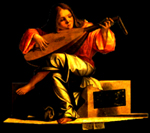 |
 |
|
|
Streaks Recognition for Casino Slots/ Streaks Method & Slots Thermometer |
 |
 |
|
|
Streaks Recognition for Casino Slots/ Streaks Method & Slots Thermometer |
Streaks
Method
![]() Slots Thermometer
Slots Thermometer
 |
 |
The History of Slots
*******************************************************************
First
Machine
Slots
in Prohibition Era
Pre-World
War II years
Slots
in modern time
The history of Slots started in 1897 when inventor Charles
Fey built first Slot machine
in his workshop on Market Street in San Francisco.
For the love of Liberty he called his contraption “Liberty Bell”. The liberation
of the players from their money began in earnest. Fey’s invention had 3 reels
with 10 symbols on each reel. Cards suits were used for symbols – hearts,
diamonds, spades and clubs – and also bells, horseshoes and stars. The machine
had a slot to insert a coin and a bottom tray to pick up the winnings. A little
window allowed a player to see one row of the symbols lining up in a losing or
winning combination.
Liberty Bell’s jackpot was 3 bells rewarding a winner with
20 drinks. Machines also paid out in cigars and chewing gum. Their first main
purpose was to boost and maintain traffic of customers into saloons, small
markets and other establishments. The machines sat on the bar tops. Their size
was small in comparison with modern slots. Charles was renting the machines to
those establishments on a 50%-50% basis. Machines acquired their true identity
as the gambling devices few years later when they started to pay out in coins.
Fey’s revolutionary invention didn’t go unnoticed. Few more
manufacturers followed his lead into a new frontier. Herbert Mills was smart and
daring enough to clone Fey’s machine and produce his own version around 1900.
Obviously, the lack of originality was not limited to a basic design and machine
was named “Operators Bell”. There were few differences however. Mills’ machine
had 20 symbols instead of 10. New symbols included bars, bells and fruits –
plums, lemons and cherries.
Mills certainly had his moments with a machine and a larger
window displaying symbols was the proof of that. It let players to see 3 lines
of symbols instead of only one on Fey’s machine. Centerline was a payoff line,
but a line above and below
Former associate of Mills O.D.Jennings formed his own
company responsible for many innovations in slots design. In 1950-1960 he
introduced first multi-line machines with 5 payoff lines – 3 horizontal lines
and 2 diagonal ones. 4 reels and electric lights were also Jennings’
contributions into further evolution of slots design.
The lion share of modern Slots market belongs to a handful
of major manufacturers. The biggest are Bally Corporation and International
Gaming Technologies. Other
important players in the industry are: Sigma Game Inc., producing the most
successful horse racing machine; Casino Electronics Inc. with its line of Video
Poker, Video Blackjack and Keno machines; Williams offering a number of very
popular reel and video slots titles etc.
Around 1910 Government started a crusade against gambling
and bureaucrats conceived a number of anti-gambling laws. In order to survive
slots had to be tricky. They followed wolves into a sheep cloth to masquerade
themselves as vending machines – they took coins but paid back in candy, gum
etc. A player could exchange won products into cash inside the establishment.
During Prohibition era slots disappeared from a public view
into the back rooms of speakeasies where they found a political asylum and a
safe haven under the mob’s wing. There was no need for hypocrisy in the dark
corners of Prohibition, and slots were paying back in cash in those places.
In 1934 Prohibition ended but slots continued to be under
attack. New York mayor La Guardia was going against slots with a sledgehammer in
his hands. The only place where slots and a law were no longer enemies was
Nevada where gambling was legalized in 1931.
Other places where players could court Lady Luck were
gambling ships: 3 miles from a coastline and ships were in international waters
immune from U.S. laws. In 1939 Government knocked gambling ships out of
business.
After legalization of gambling in 1978 in Atlantic City and
in 1990s in Indian reservations all over the country slots really took off and
blossomed like multicolored flowers all over the map of United States. It was
about time – gambling is as old as human civilization. Representing the love for
money, competition and excitement it is as intrinsic to a human nature as the
need for sex. No bureaucrats, moralists, social engineers and utopists of any
kind will be able to stop it. No wonder, over the years slots proved to be true
survivors. Slots in casinos and sluts on the streets will always be there to
play with.
